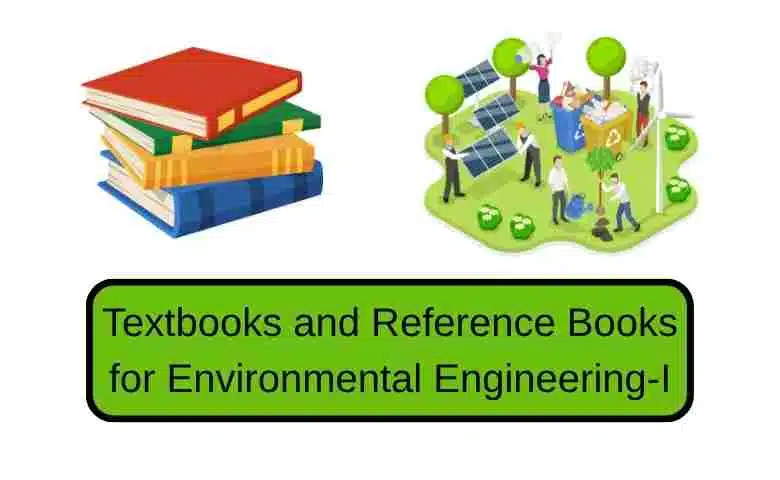Last Updated on June 18, 2025 by Admin
Environmental Engineering is a vital discipline within civil engineering that focuses on the sustainable management of water, air, and environmental resources. The Environmental Engineering-I course, generally offered in the early stages of undergraduate civil engineering programs, primarily covers water supply systems, water treatment, and basic environmental sanitation.
To help students, professionals, and educators stay updated with quality resources, we’ve compiled an authoritative list of textbooks, reference books, and suggested readings that are relevant for the Environmental Engineering-I curriculum, including some classics and recent additions as of 2025.
Table of Contents
Core Reference Books for Environmental Engineering-I
-
Environmental Engineering by Peavy, Rowe
Publisher: McGraw Hill Publications
This foundational book covers water treatment, air pollution, solid waste, and environmental systems in a comprehensive and analytical way. It’s well-suited for both academic coursework and professional reference. -
Optimal Design of Water Distribution Networks by P. R. Bhave
Publisher: Narosa Publishing House
Ideal for advanced learners, this book focuses on the mathematical modeling and optimal design of water supply networks, using hydraulic principles and optimization techniques. -
Rainwater Harvesting: Making Water Everybody’s Business
Published by Centre for Science and Environment (CSE)
A practical and community-focused approach to sustainable water resource management through rainwater harvesting techniques. -
Harvesting Faith by Linda K. Hubalek
Publisher: Butterfield Books
Though not a technical book, it offers cultural and historical perspectives on water conservation practices, making it a supplementary reading for understanding the social context. -
CPHEEO Manual on Water Supply & Treatment
Published by the Central Public Health and Environmental Engineering Organisation, Govt. of India
A standard and indispensable manual for Indian engineers and practitioners in the water supply and treatment domain. Frequently cited in government projects and academic institutions. -
Standard Methods for the Examination of Water and Waste Water (20th Edition)
Published by: American Public Health Association (APHA)
This international standard is a must-have for laboratory procedures and water quality testing protocols.
Essential Textbooks for Environmental Engineering-I
-
Water Supply Engineering by S. K. Garg
Publisher: Khanna Publishers, New Delhi
A detailed book that covers planning, design, and operation of water supply systems, pipelines, pumps, and treatment processes. -
Water Supply and Sanitary Engineering by G. S. Birdie and J. S. Birdie
Publisher: Dhanpat Rai Publishing Company
Covers water and wastewater engineering basics with illustrative diagrams and case studies. -
Environmental Engineering I: Water Supply Engineering by B. C. Punmia, Ashok Jain, Arun Jain
Publisher: Laxmi Publications (P) Ltd
Known for its student-friendly language, solved numerical problems, and exam-oriented content. -
Air Pollution by H. V. N. Rao and M. N. Rao
Publisher: TMH Publications
This book complements the Environmental Engineering-II course but also helps students understand air pollution basics in introductory modules. -
Theory and Practice of Water and Wastewater Treatment
Publisher: Wiley
A comprehensive guide to both water and wastewater engineering with real-world problem-solving strategies. -
Water Supply and Treatment Manual
Publisher: Government of India Publication
Standard manual for design guidelines in Indian infrastructure projects. -
Wastewater Treatment – Concept Design and Approach by C. L. Karia, R. A. Christian
Publisher: PHI
It presents a systematic and design-oriented approach toward wastewater treatment plants. -
Environmental Remote Sensing from Regional to Global Scales, Edited by Giles Foody
Publisher: Wiley
A modern textbook for understanding environmental monitoring using remote sensing technologies. -
Water Supply and Sanitary Engineering by G. S. Birdie and J. S. Birdie (Listed again due to its relevance in both theory and practice).
Suggested Additional Readings for Deeper Understanding
-
Environmental Engineering by N. N. Barak – MGH
-
Environmental Engineering by Venugopal Rao – PHI
-
Environmental Engineering by Steel and McGhee – MGH
-
Water Supply & Engineering by Pande and Carne – Tata McGraw Hill
-
Water Supply Engineering by Harold Eaton Babbit & James Joseph Doland – MGH
-
Principles of Water Treatment by Keny J. Howe – MWH
-
Water Treatment: Principles & Design (3rd Edition) by John C. Crittenden, R. Rhodes
-
Water Quality & Treatment: Handbook on Drinking Water (6th Edition) by James K. Edzwald
-
Environmental Engineering Laboratory Manual by B. Kotain & Dr. N. Kumarswamy
-
NEERJ Environmental Engineering Laboratory Manual
Importance of Standard Laboratory Manuals
For practical lab sessions, standardized manuals such as those published by NEERJ, APHA, and individual academic institutions (like IITs or state engineering colleges) help bridge the gap between theory and application. These are crucial for understanding real-world analysis, equipment usage, and experimental validation.
Practice 15+ AI-generated technical and HR interview questions for Civil, BIM, QS, Planning, HSE and Construction roles. Get instant feedback, improved answers, a 7-day improvement plan, and a full PDF report. Designed exclusively for construction professionals.
One free full interview session included. No credit card required.
Final Thoughts
Selecting the right combination of textbooks and reference materials is crucial for mastering Environmental Engineering-I. The books listed above cover a wide spectrum, ranging from theoretical principles and practical applications to government standards and design techniques. Whether you’re a student preparing for university exams, a GATE aspirant, or a professional looking to refresh your knowledge, this comprehensive guide is your go-to resource.
Related Posts:
- Best Water Treatment and Water Technology Companies in India [ Updated List]
- What You Need to Know About TILE
- Civil Engineering Books, Textbooks and Reference Books
- The Best Construction Management Books For 2025


